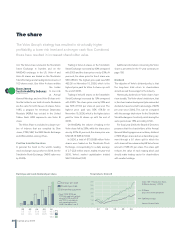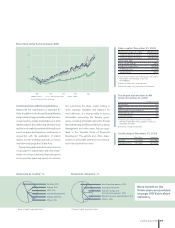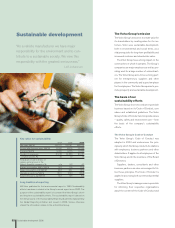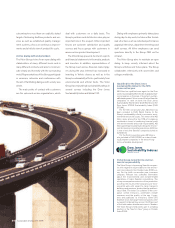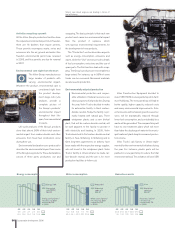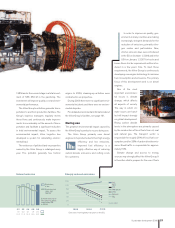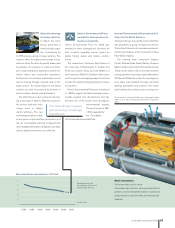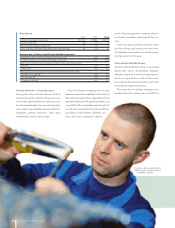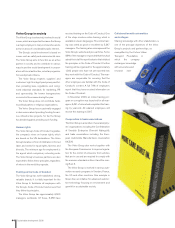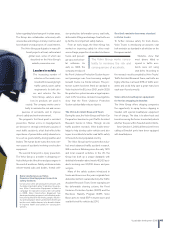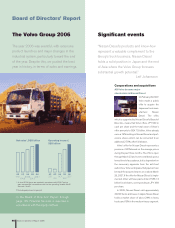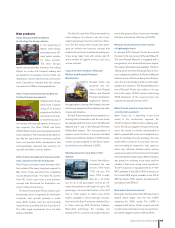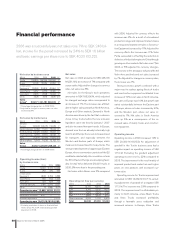Volvo 2006 Annual Report Download - page 44
Download and view the complete annual report
Please find page 44 of the 2006 Volvo annual report below. You can navigate through the pages in the report by either clicking on the pages listed below, or by using the keyword search tool below to find specific information within the annual report.
sumption per produced truck dropped by over
60% between 2001 and 2005. Through
increased waste separation and a recycling
program, the quantity of deposited waste was
halved between 2000 and 2005, while recy-
cling increased by over 75%. The investments
in the project paid off in less than three years,
and the long-term savings are estimated at
around SEK 11 M per year.
Thanks to its dramatic reduction of green-
house emissions, the New River Valley factory
is among the leading vehicle factories in the so-
called Climate Leader program instituted by
the American EPA environmental agency to
reduce carbon-dioxide emissions. Emissions
dropped by 27% per produced truck in 2003–
2004.
Environmental Prize awarded to Volvo
Powertrain North America
Volvo Powertrain in Hagerstown, Maryland, in
the US was awarded a prize by the organiza -
tion Businesses for the Bay for outstanding
environmental efforts. Volvo Powertrain in
Hagerstown manufactures engines for Mack
Trucks and Volvo Trucks in North America.
Businesses for the Bay works to protect and
preserve the environment around Chesapeake
Bay in Maryland on America’s east coast. Volvo
Powertrain has implemented several positive
environmental measures at its factory and has
won the prize for “Outstanding Achievement for
Pollution Prevention at a Large Facility”.
Volvo Powertrain has carried out numerous
environmental initiatives for sustainable devel-
opment. These include introducing a new, more
efficient heating system that can operate on
non-fossil fuels. All leakage water from produc-
tion processes is cleaned and recycled at the
factory, for instance as cooling water. The
building’s lighting and insulation systems have
been upgraded to maximize energy efficiency.
Social responsibility
The Volvo Group aims to be a good citizen that complies with laws
and regulations and generally acts responsibly and respectfully.
The Volvo Group promotes equal opportunities, fairness and diver-
sity. Employees should be offered stimulating work in a healthy, safe
environment.
The Group’s employees and their
knowledge and competence are a
crucial prerequisite in achieving the
corporate vision.
their own skills. By putting words into action,
focusing on implementation and carrying out
necessary changes faster than the competi-
tion, the Volvo Group aims to secure long-term
success.
The employees’ working conditions
Achieving success on individual markets
requires extensive knowledge of the conditions
prevailing on that market. It takes a long time to
build up this knowledge and experience, so it is
vital that the composition of management and
other employees throughout the world reflects
the societies in which
they operate. At all the
larger facilities, the
majority of the manag-
ers and employees are
from the country or
region in question.
All employees have access via the intranet to
guidelines regarding HR policies, values,
recruitment and employment, salaries and
benefits, employee appraisal sessions and
competence development.
The policy for wages, salaries and remunera-
tions is based on the Group’s basic values and
principles as formulated in The Volvo Way. They
support the Group’s efforts to realize its visions
and business goals.
Wages, salaries and remunerations should
contribute to Volvo’s image as an attractive
company. Behavior in line with the Company’s
Volvo as an employer
The Volvo Group’s vision is to be regarded as a
globally leading supplier of commercial trans-
port solutions. The Group’s employees and
their knowledge and competence are a crucial
prerequisite in achieving this vision. The Group
aims to be the first-choice employer of both
current and future employees.
The Group had 83,187 employees at the end
of 2006. Each employee is part of a team and is
expected to participate actively in the Group’s
development, change process and future. To
support this aim, an environment character-
ized by energy,
passion and res-
pect for individuals
is required.
Corporate
culture a determining factor
The ability to develop a competitive corporate
culture is of critical long-term importance to
the Group’s profitability. Unlike technologies,
strategies, structures and business models, a
corporate culture is unique and difficult for
competitors to copy.
The Volvo Group’s values and culture are
outlined in the book entitled “The Volvo Way”,
whose principles guide both managers and
employees in their daily work.
The Volvo Way is based on the conviction
that all employees have the ability and desire to
improve operations and, by so doing, to develop
40 Sustainable development 2006


